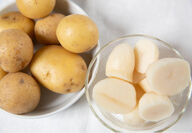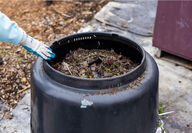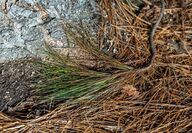Sorted by date Results 1 - 25 of 157

Pruning of highbush blueberries done every year can make the difference between a mediocre and a bumper crop – and production of quality fruit. Highbush blueberry, a native of North America, grows 6 to 12 feet tall and is the major blueberry-producing species in commerce. Its name refers to its tall stature. The best time to prune is from January to early-March during the dormant period, advises Bernadine Strik, berry crops specialist with Oregon State University Extension Service. Strik’s resea...

At Oak Creek Center for Urban Horticulture, trees along the creek show signs of beavers gnawing. A doe and her fawn nibble greenery. Skunks, raccoons and even a gray fox feel at home. Birds, including a red-tailed hawk, find plenty of sustenance and shelter. Al Shay, manager of the center along with site manager Cody Buckman, works with a small retinue of students to keep the center wildlife friendly. Their efforts recently garnered the center Certified Wildlife Habitat status by the National...

Once grape vines lose their leaves, the plants fade into the background of the winter landscape. That’s the time to take action and get out the clippers. January through the first of March is the season to prune your vines, said Erica Chernoh, an Oregon State University Extension Service horticulturist. First, though, you’ve got to know how to do it properly. “Home grape growers don't prune their vines enough,” Chernoh said. “When gardeners prune, they should remove the majority of wood prod...

For gardeners, January is a kind of second Christmas — mailboxes overflowing with seed catalogs and gardeners’ imaginations filled with visions of new varieties, bountiful flowers, and tasty produce. There’s a long road between the fantasy gardens of January and the summer harvest. That road starts with seeds. Here are five things to consider when trying to narrow down the multitude of choices to selections that can reasonably fit your yard, time, and budget. Choose varieties with shorter harves...

The plant world teems with appropriately sized trees. The best place to start a search is in your own backyard. As the saying goes: “Right plant, right place.” Decide where you want a tree first and then find one that fits the site, said Chris Rusch, an Oregon State University Extension Service Master Gardener in Douglas County. “You can’t just go buy a tree and then find a spot for it,” she said. “You have to get a tree that’s suitable for the site.” Take into account the amount of sun t...

Traditional holiday arrangements are full of scented or berried evergreens, among the few garden items available to us in the winter months. Each of these greens performs differently, both in an arrangement and in the landscape. A closer look at some of the popular greens frequently used in these decorations provides insight into long-standing tradition as well as tips for using greenery in our modern homes. Records of bringing evergreens indoors during the winter months are recorded as far...

Winter-blooming indoor plants are a welcome way to take the edge off the chill and gloom of winter and make delightful gifts for the holidays. The choices go beyond traditional poinsettias and amaryllis. Colorful African violets, gloxinia, cyclamen, orchids, ornamental peppers and Christmas cactus are blooming and readily available. Dress them up with bows and cellophane or combine a few in a basket with store-bought or garden-harvested moss and some decorations and present them as gifts or to...

When botanist John Bartram first identified a hydrangea native to the U.S. in the 1730s, little did he know it would become a mainstay of the garden with its iconic flowers implying romance with their blustery beauty. Hydrangeas populate millions of gardens and with good reason. They can be used as specimens in a place of honor, as partners in mixed beds, in containers and even as hedges, said Heather Stoven, a horticulturist with Oregon State University Extension Service. And with the...

Any time of year is a good time to start a budget, so why not now? You haven’t forgotten those frugal resolutions, have you? Since the gardening season is still a few months away, there’s a good stretch to set financial priorities. “Gardening is like any other hobby,” said Brooke Edmunds, a horticulturist with Oregon State University Extension Service. “It takes some level of investment. But it doesn’t have to be that expensive. There are shortcuts.” Some of them are easy. Buying smaller plant...

As the outdoor gardening season reaches its conclusion, cool temperatures and shorter daylight hours take over. That means it's time to winterize gardens and position them for continued health and beauty over the winter months. For ornamental gardens and foundation plantings, it’s time to complete a few tasks, but heavy pruning of “woodies” — trees and shrubs — is best left to late winter. Pruning in the fall or early winter might encourage new growth that's later damaged by frost. Exception...

Snipping some cuttings from the garden this time of year will produce your own private nursery of plants by spring. Whether you plant the results of your “snip and stick” project or give them away, propagating by cuttings can be a rewarding process. Although some sources of information can be intimidating, Neil Bell, a horticulturist for Oregon State University Extension Service, has good news. “I do lots of them at home,” he said. “I don’t use a greenhouse or even bottom heat. What that means...

If your compost pile at home isn't getting hot, don't worry. That heap of yard debris and kitchen waste may be far from steamy, but it will break down eventually. That eases the burden on your local landfill or recycling center and provides a nutrient-rich product with ample benefits for your garden. Cool, slow composting is an easy method for people who don’t have the time or desire to tend to a hot compost pile. Hot composting requires a fairly precise recipe of ingredients and a c...

As pumpkins and winter squash reach harvest time, gardeners wonder how and where to store them. Since they won’t survive the first frost, now’s the time to plan a strategy. Tried-and-true storing techniques can keep some winter squash for several months. “Most squashes and pumpkins are warm-season crops and are susceptible to injury at temperatures less than 50 degrees,” said Gail Langellotto, an Oregon State University Extension Service horticulturist. “If left out in the garden too long, the...

Yes, you are correct that the fig leaves will eventually rot and the nutrients from them will make their way into the soil. You should monitor the health of your fig tree throughout the year and look for any disease and/or insect issues. If you see fungal spotting on leaves then you should rake up the leaves and dispose of them such as in your yard waste container. Fungal spores from infected leaves can remain over winter, and when new leaves come out in the spring, infect the leaves once more....

“You plant spring-flowering bulbs in fall; they grow over winter, flourish in spring, and go dormant in summer,” said Heather Stoven, a horticulturist with the Oregon State University Extension Service. “Once they’re in the ground, they do quite well over multiple years with little maintenance.” On top of that, bulbs are drought-tolerant. “That’s one of the great things about them,” Stoven said. “Since they go dormant in summer, they don’t need to be watered.” She said that if you plan to i...

As the gardening season winds down and you pick the season’s last vegetables, let some plants go to seed and harvest them for planting next year. Saving seeds can be fun and is a great way to learn about plants. If you choose the right types of vegetables, you can keep them going year after year without buying them again. The key to saving seed is selecting open-pollinated or heirloom plants, which produce offspring with the same traits. Hybrids are bred from two different varieties for characte...

Would you like your homegrown potatoes to stay fresh and last longer? Research has shown there are best practices to harvesting and storing potatoes to ensure freshness. First, check for harvest maturity by digging up a potato. If the skin rubs off easily, wait another week before harvesting, said Heidi Noordijk, Oregon State University Extension Service Small Farms coordinator. To help prepare potatoes for storage, cut back on watering in mid-August. Let the vines die back before harvesting....

In spring garden centers will stock a tempting array of brightly colored tuberous begonias that are hard to resist. Gardeners have a tremendous choice of flower color in shades of orange, pink, yellow, white, and bi-colored. But these lush plants don’t grow over winter outside and must be protected. The tubers can be saved and planted again the next spring for another year of showy color. The tuberous begonias should not be confused with the low-growing wax begonias often called annual b...

Just as we begin to think about wrapping things up in the garden for the season, slugs slither out of their homes underground to lay their eggs for next year. That means it’s time again to slug it out with one of the gardener’s most familiar, frustrating, and certainly slimiest pests. “What slugs want is a place that’s warm and moist,” said Claudia Groth, an Oregon State University Extension Service Master Gardener. “That’s why spring and fall is when they’re most active. They’ll be comi...

While the practice of no-till gardening is not new, information has traditionally centered on agricultural field crops. Now, home gardeners are catching on. “The concept of no-till has been around for a couple of decades, but research has been very focused on field crops like wheat and corn, things largely grown in the Midwest,” said Erica Chernoh, Oregon State University Extension Service horticulturist. “There’s not much on vegetable production or fruit. There’s a lot to learn, and research...

Though they look tropical and taste exotic, figs grow fine in the long corridor of Western Oregon, where the climate offers not-too-cold winters and hot enough summers. The cooler summers of the coast and colder winter temperatures east of the Cascades are a different story, though. The weather in those areas is not conducive to growing the love-it or leave-it fruit. Not all varieties of figs thrive, however. Of 100 or more cultivars, Cody Copp, Oregon State University Extension Service...

For a hedge, arborvitae has a place. It’s tall, skinny, evergreen, low maintenance, and cheap. “Some people look down on arborvitae, but it fits in places that other things can’t,” said Neil Bell, a retired horticulturist for Oregon State University Extension Service. “And it’s about as low maintenance a plant as anything you can buy if it’s sited correctly.” When finding a location for arborvitae in the garden, Bell recommends full sun and well-drained soil. “They can take some afternoon sh...

Would you like your homegrown potatoes to stay fresh and last longer? Research has shown there are best practices for harvesting and storing potatoes to ensure freshness. First, check for harvest maturity by digging up a potato. If the skin rubs off easily, wait another week before harvesting, said Heidi Noordijk, Oregon State University Extension Service Small Farms coordinator. To help prepare potatoes for storage, cut back on watering in mid-August. Let the vines die back before harvesting....

Seeing rats in the backyard or, worse yet, in the house, can send people into panic mode, and for good reason. “There are definite social norms that say if you have rodents living near you it’s associated with dirtiness, garbage, and waste products,” said Dana Sanchez, wildlife specialist for Oregon State University Extension Service. “There’s a reticence to admitting to seeing rats or talking about them because there’s a fear of public shaming. That works to the rats’ advantage because peopl...

Reality can get skewed when there are so many sources of information - books, magazines, newspapers, nurseries, and, most of all, the internet and social media open up lots of room for contradiction. So, how do you find the right answer to gardening questions? Experts from Oregon State University Extension Service stepped up to bust some common gardening myths. Read on to get some research-based answers to 10 common misconceptions. For additional questions, call the OSU Extension Master...